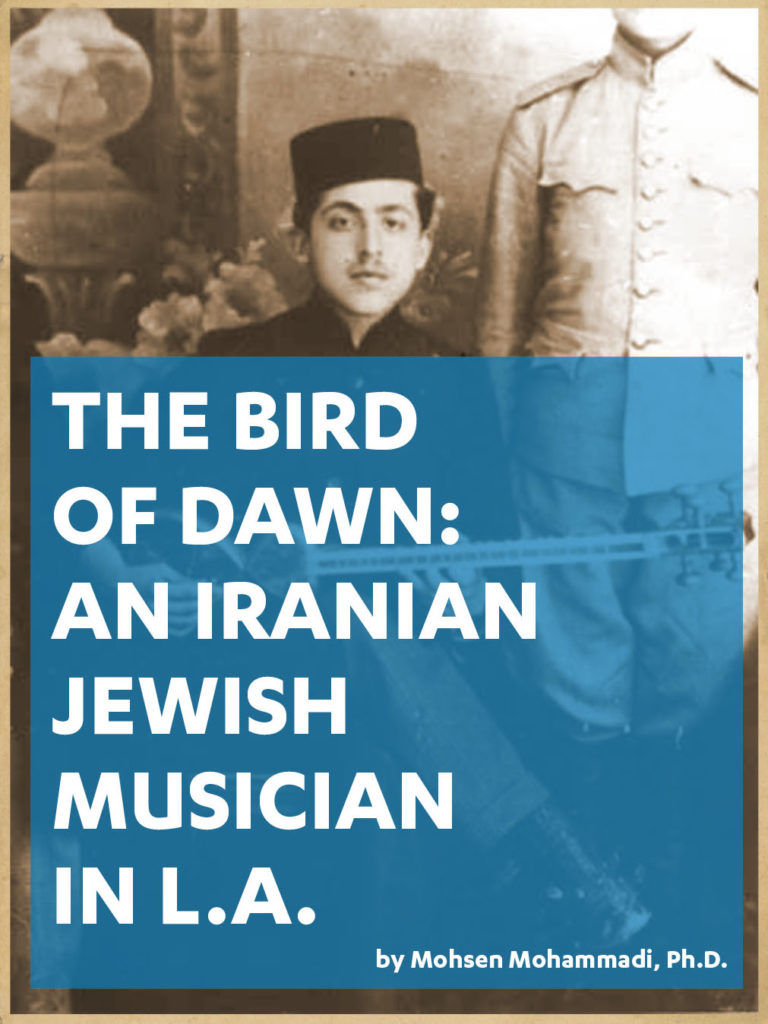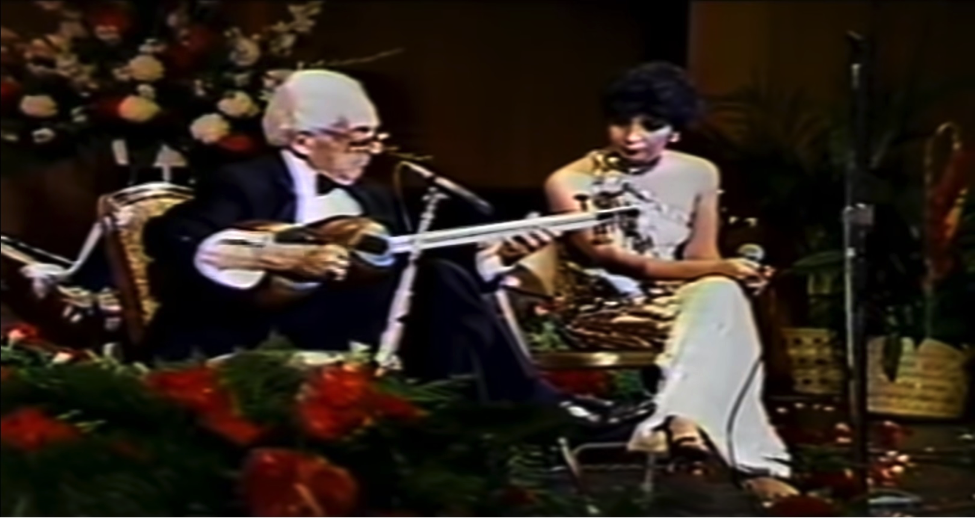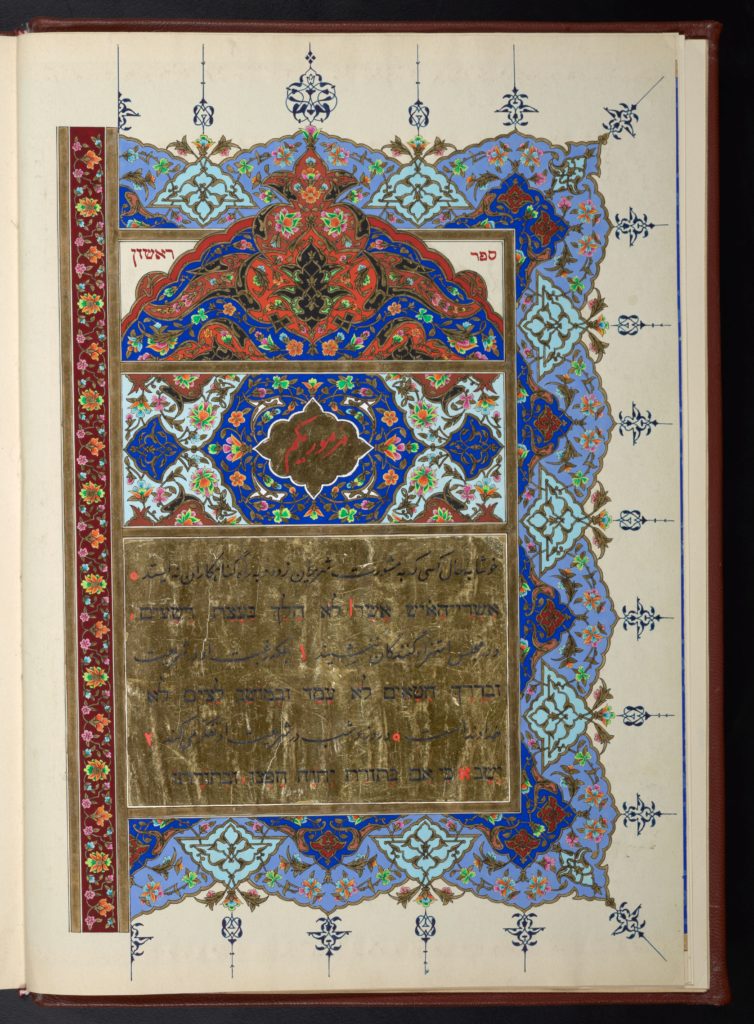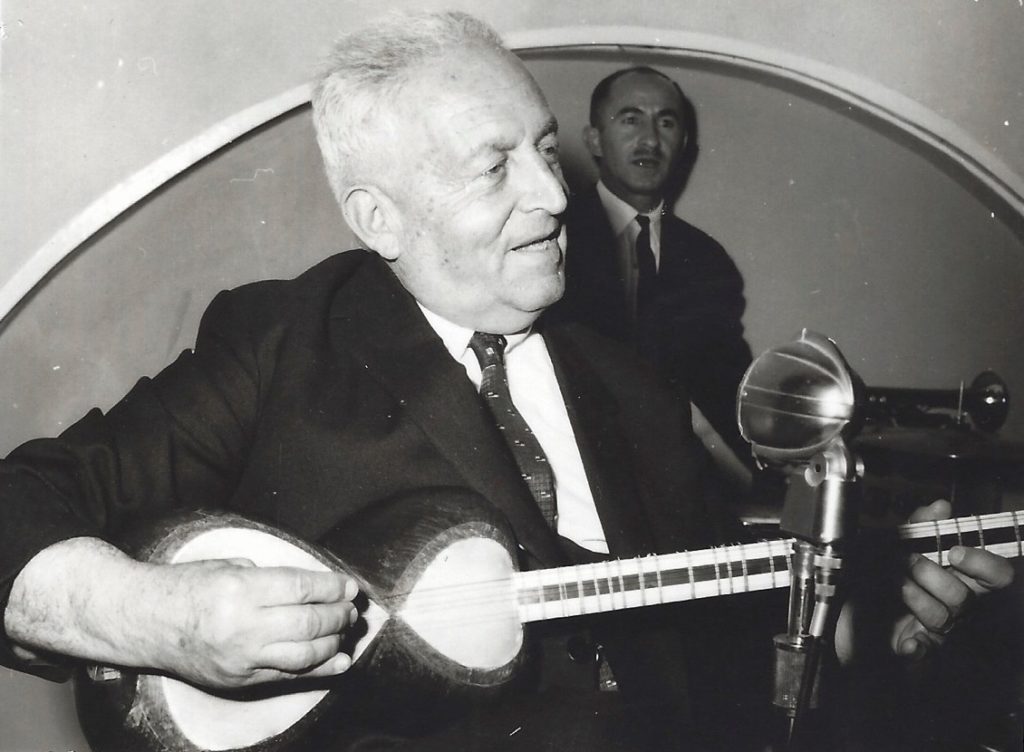

On Monday, September 17, 1984, Iranians from across Los Angeles gathered at the historic Wilshire Ebell Theater for an extraordinary event. They had been forced to an exile after the Islamic revolution in 1979, and after five years of struggle to settle down in a new hometown, they were eager to see a legendary Iranian musician perform live in Los Angeles, a star of gramophone era who rarely performed live. Many Iranians also suffered from the Americans’ hostile response to the Iran hostage crisis, when Iranian revolutionary forces detained American diplomats and citizens for 444 days. In such a situation, an iconic live performance by a legendary master musician was a moment of joy and pride, it brought all Iranians together and it made them proud of their Iranian identity. The master musician was none other than the legendary Iranian Jewish musician, Morteza Neidavoud (1900-1990).

Jewish Culture in Iranian Music
In his 1972 article on Jewish musicians in Shiraz, Laurence D. Loeb lamented the lack of available sources and scholarship related to Jewish musicians, professional or amateur, prior to the nineteenth century. His piece, which explored the works of Jewish poets Maulana Shahin (fourteenth century) and Imrani (sixteenth century), postulated that given the Jewish interest in secular Persian poetry, Jews undoubtedly participated in Persian musical performance prior to the seventeenth century as well.1

Persian manuscripts on music evidence the connections between Iranian music and Jewish culture that Loeb suggested. The manuscripts reveal aspects of the Iranian cosmology in the past, presenting several stories that associate the creation of music to the planets, prophets, and even Plato and Pythagoras. Beginning in the thirteenth century, theoretical discourses on Persian music focused on a set of twelve modal entities called maqam. Some manuscripts associated the maqam to Jews: for example, one manuscript stated that Pythagoras learned the twelve maqams, or the knowledge of Persian music, from David, the King of Israel:
“They have stated in most books that Pythagoras learned and acquired this knowledge from His Holiness David – peace be upon him – and this narrative is the most truthful; and prior to David’s era, the maqam and other tunes did not exist, and David recited and rendered the Book of Zabur [Mizmor] in the twelve maqam.”2
Jewish culture was associated with musical instruments as well. Abdol-Qāder Marāghi stated in his book, Maqāsed-ol-Alhān (fifteenth century), that “the Israelites invented Mazāmir [reeds], and all of the wind instruments, according to the voice reeds of David – Peace Be Upon Him – because [creating] fine tunes was his miracle.”3 Mazāmir (plural of mizmār) was an Arabic term for wind instruments, and the Arabic title for the book of Psalms, an anthology of sacred songs which were mainly linked to the name of David, the King of the Israelites. Mizmār is the Arabic version of the Hebrew term, mizmor, which means melody and singing.
Marāghi also included a list of musical instruments in his book, in which he described a black wood instrument called Zemer Siyah-Nāy, or Zemer Black-reed. Zemer refers to music in Hebrew and it is integrated in the word Klezemer, meaning musical instrument, which today is a common term for the Jewish music from Eastern Europe. As Marāghi described: Zemer refers to music in Hebrew and it is integrated in the word Klezemer, meaning musical instrument, which today is a common term for the Jewish music from Eastern Europe. As Marāghi described:
“Zemer-Siyah-Nāy is about the half size of white nāy [the common nay], but blowing in it is constant [circular], because the player inhales air from nose and keeps it in the mouth and blows it out as needed. Zemer-Siyah-Nāy has a wider range in composing tunes than the white nay, and producing note in Zemer-Siyah-Nāy is also by blowing intensity and closing and opening holes.”4
Another legend relates the creation of music to the Exodus and the journey of the twelve tribes of the Israelites at Sinai, alleging that the twelve maqams, or the knowledge of Persian music, were first discovered by Moses during that journey:
“Know that there are different opinions about the emergence of musiqi [music]. Some say that when Musā [Moses] entered the Nile River, he saw a rock in the sea. Gabriel – peace be upon him – said: Moses! Take that rock, it will be useful to you! Moses took the rock. When he entered desert with his tribe and stayed there for forty days, thirst assailed them. His Holiness Moses prayed. Gabriel appeared and said: Musā! Hit that rock with your rod. When he did, a fountain sprang from it and branched into twelve parts, and from each a sound appeared. Gabriel – peace be upon him – said: Musā! Qi! Meaning take it! And Moses – peace be upon him – learned the twelve maqams, and after being used repeatedly, that articulation of Musā! Qi! became musiqi.”5
Khājeh Kalān of Khorasan, a musician and writer from the seventeenth century, added more elaboration on the origin of musiqi. Noting that in Hebrew “mu” related to water, and “siq” related to driven water, he asserted that the twelve maqams were derived from the sound of the twelve springs of Elim, as described in the book of Exodus. Each spring produced the sound of one maqam, thus each of the twelve tribes recognized their spring by the sound of the maqam it produced. He added that since the twelve maqams were derived from the sounds of the springs of the twelve tribes of Israel, they bring tears to eyes and put listeners into trance.6
Minorities in Iranian Music
Whereas the Roman Catholic Church embraced the pipe organ as part of its liturgical practice, thereby legitimizing its use as a musical instrument and medium for composition outside of the church, in Iran, only religious chanting was permissible. Recitation of the Quran, call for prayer (Azān), passion preaching (Rowzeh), and passion play (Tazieh) were among the only religiously-legitimate musical performances in Iranian society. Playing an instrument was totally forbidden according to Islamic Sharia, however, special occasions, festivities and life cycle events such as weddings needed instrumental music. As a result, for non-Muslim minorities–already regarded as najis (or unclean)–playing instrumental music and other disrespected or prohibited professions, such as producing alcohol, offered career opportunities. Thus, instrumental music was a craft that was disproportionately practiced by non-Muslim religious minorities in Iran, particularly Jews and Armenians.
In writing about the disproportionate role of minorities in Iranian music, Bruno Nettl, who studied music in Iran in the 1960s and 1970s, observed similar trends in the United States, noting the high numbers of Italian and Jewish immigrants and African Americans in the music industry. But in the case of Iran, he argued, there was an important caveat. As he described:
“Traditional Iranians define music more narrowly than do most Europeans, for they exclude certain genres such as chanting the Koran and related liturgical performance. Devout Shiites question the appropriateness of hearing certain kinds of music—in certain contexts, by certain people, or at all. I believe that the key to the role minorities play in music lies in the need to reconcile the devout Muslims’ ambivalence about music with the larger population’s interest in having a full musical life. Most obvious may be the idea that musicians are themselves a minority. Professional musicians in both the vernacular and the classical music sectors lived a life apart; they espoused values that conflicted somewhat with the majority’s, they behaved differently, and they kept their activities somewhat under cover, staying home from work on minor holidays and not admitting that their main livelihood came from music… Disrespect for both minorities and music also helps explain why urban Muslims who are experts in music often did not wish to be considered professional musicians but rather prefer (or preferred, before 1978) to be regarded as learned amateurs.”7
Navigating the boundaries of propriety impacted Jews as well: although many Jewish families performed music and Jews were among the most prominent musicians in nineteenth century Iran, many of them outwardly professed Islam so as to be able to attend the Persian Court and houses of nobilities. These included Chalanchi Khan (d.1836), who became the Motreb-bashi (Head of musicians) of the Shah of Iran in early nineteenth century, Fath-Ali Shah (1797-1834).8

The Jewish community in Iran also established one of the first theater groups in Tehran in the late 1910s. In March 1920, they performed a play featuring the story of Ahasuerus and Esther in a hall at the famous Grand Hotel in Tehran with support from Iran’s Zionist Organization. A few years later, a second group called Comédie Omid Israélite Téhéran was established. And, in roughly the same years, as radio and phonograph technology expanded, Iranian Jewish musicians became prominent parts of a burgeoning music broadcast and recording scene in Tehran. Well-known Iranian Jewish musicians include Soleyman Ruh-afza (1900-1995), the first to record a version of the Iranian music repertoire (radif), and Yahya Zarpanjeh (1900-1932), and, most prominent of all, Morteza Neidavoud (1900-1990).9
Solo performance by Morteza Neidavoud on the tar, recorded in 1926 by the Gramophone Company, catalog number 7-219278, reissued as HMV AX389.
Morteza Neidavoud, Star of Iranian Music
Morteza Neidavoud was born to a Jewish family in Tehran in 1900. Legend has it that the Neidavoud’s name resulted from a new Iranian government law that was introduced in the years after World War I, requiring that all Iranians declare family names. Morteza’s father, Bālā Khan, spoke to the great Iranian musician, Darvish Khan, who was Morteza’s teacher. Darvish told him that they should chose Neidavoud, a Persian mode, for their family name, because it would relate to their Jewish background. Nei or Ney, means reed in Persian, and Davoud is David–thus, Neidavoud refers to the reed of King David.

Morteza’s father was a musician, so it was natural for his sons to play an instrument. Morteza and his brother, Soleyman, picked the tar. Their brother, Musa, picked the kamāncheh and then the violin. Morteza started playing the tar and by the time he was six years old, his extraordinary talent in music was obvious. His father took him to meet with and learn from Āqā Hoseyn-Qoli, a famous musician in those days. At the same time, Morteza attended Madreseh Alliance, the first school of Alliance Israélite Universelle opened in Tehran in 1900.

Morteza learned the repertoire of Iranian music from Āqā Hoseyn-Qoli in just a few years. Āqā Hoseyn-Qoli suggested to Bālā Khan that he should take Morteza to study with his best student, Gholām-Hoseyn Khan, aka, Darvish Khan. Darvish had developed an innovative style of composing and performing Iranian music, and Morteza started learning Darvish Khan’s style. Darvish was deeply impressed by Morteza’s musical talent and later Morteza was granted permission to teach some of Darvish’s students. After Darvish passed away in 1926, the young Morteza opened his own music school, naming it “Darvish” in memory of his late teacher.
In the same year, the Gramophone Company decided to arrange new recordings of Iranian music. No new recordings had been circulated in Iran for more than ten years due to World War I, and as such, there was a high demand for newly pressed records. In addition, Iranian society and arts had changed dramatically, and recording new styles of music was necessary and would become very popular.
A recording session in Baghdad and Tehran was arranged by the Gramophone Company’s local agent, Ezra Meir Hakkak & Sons, a Jewish firm based in Baghdad. Perhaps it was one of the Hakkaks who discovered Morteza Neidavoud and signed a recording contract with him. The result of the recording session in 1926 was extraordinary. Not only did Morteza Neidavoud became a star of Iranian music, but he also introduced two singers who had been students of his and later became the most famous singers of their time: Moluk Zarrabi and Qamar-ol-Moluk Vaziri.
Shāh-e Man Māh-e Man, Qamar-ol-Moluk Vaziri accompanied by Morteza Neidavoud on the tar and Musa Neidavoud on the violin.
Soon rival record labels entered the Iranian market, expanding the musical reach of both Morteza Khan, on the tar, and Musa Khan, on the violin. Their music was recorded by multiple labels, including Polyphon, Parlophon, and Baidaphon. Morteza Neidavoud composed several songs that were also released on those labels which remain some of the most beloved songs in Iranians’ memory. Shāh-e Man Māh-e Man (O! My King! My Moon!), is one of his songs that has been transformed into the most famous instrumental piece of Iranian classical music.

In 1940, Radio Tehran was established and Morteza Neidavoud became a leading musician in live radio performances. The Iranian music scene changed dramatically after World War II, and Iranian traditional music was marginalized for several years by more popular music genres. These changes brought Morteza Neidavoud’s music career to an end, although his passion for music never diminished and he kept playing tar at home. After the Iranian Revolution in 1979, he left Iran and lived the rest of his life in California. His last public performance was in Los Angeles in 1984, at the age of 84. He passed away on July 31, 1990, and was buried in Colma, California.
Legacy
Of all of Morteza Neidavoud’s many recordings in the 1920s and 1930s, Morgh-e Sahar (The Bird of Dawn) has become the most iconic, travelling far beyond the borders of Iran. Owed to its social justice themes, the song became an anthem of the protests against the Islamic regime after the 1979 revolution. The legendary Iranian singer, Mohammad-Reza Shajarian, sang Morgh-e Sahar as encore in one of his early tours in the United States in 1990 and subsequently started playing it in Iran as well. While protesting Iranian regime in any form was brutally cracked down, masters of Iranian music including Hossein Alizadeh and Kayhan Kalhor have joined Shajarian and his son Homayun in their performances of Morgh-e Sahar. Despite its connotations, well-known to everyone in the audience, the Iranian regime could not ban singing a traditional song.
Morgh-e Sahar has gone beyond Iranian borders. The famous Azeri singer, Alim Qasimov, performed it with Azeri lyrics decades ago:
After the Green Movement in 2009, Mohammad-Reza Shajarian publicly challenged the Iranian regime by requesting Iranian TV in a public letter to stop playing a song of hope that he had sang right after revolution. He was never given permission to perform in Iran again, and after a few concerts in neighboring countries which were well-attended by Iranians, he became seriously ill and was never able to sing. Three years ago, an Iranian marketing company produced a music video of an early performance of Morgh-e Sahar by Mohammad-Reza Shajarian featuring Iranians from all walks of life lip-syncing various parts of the song while doing their every day jobs.
Morgh-e Sahar by Morteza Neidavoud has transcended boundaries of religion, ethnicity, and language. Through his music, he united all Iranians, be they Jewish or Muslim, to speak out against injustice and oppression. Thus, a legendary icon lived and became immortal by his legendary song.
Citation MLA: Mohammadi, Mohsen. “The Bird of Dawn: An Iranian Jewish Musician in L.A.” 100 Years of Sephardic Los Angeles, edited by Sarah Abrevaya Stein and Caroline Luce, UCLA Leve Center for Jewish Studies, 2020, https://sephardiclosangeles.org/portfolios/the-bird-of-dawn/.
Citation Chicago: Mohammadi, Mohsen. “The Bird of Dawn: An Iranian Jewish Musician in L.A.” In 100 Years of Sephardic Los Angeles, edited by Sarah Abrevaya Stein and Caroline Luce. Los Angeles: UCLA Leve Center for Jewish Studies, 2020. https://sephardiclosangeles.org/portfolios/the-bird-of-dawn/.
About the Author:
Mohsen Mohammadi, Ph.D., is an ethnomusicologist affiliated with the UCLA Herb Alpert School of Music …. More
Citations and Additional Resources
The author would like to express his sincere gratitude to Neidavoud’s granddaughter, Laura Younai (Neidavoud), and his second cousin, Homayoun Neidavoud, whose interviews were vital to this project.
Several interviews with Neidavoud (all in Persian) are also available for viewing online:
- Interview with Keykhosrow Behroozi, Tehran, March, 1977
- Interview with Mahmood Khoshnam, Tehran, ca. 1970s
- Interview with Jam-e Jam TV, California, September, 1984
- Interview with Mahmood Zoufonoun, California, ca. 1980s
1 Laurence D. Loeb, “The Jewish Musician and the Music of Fars,” Asian Music 4, No. 1 (1972, Near East-Turkestan Issue): 4-5.
2 Anonymous. n.d. “Treatise on Music.” Tehran, Malek Library, Ms. 494, p. 255.
3 Abdol-Qāder Marāghi. 1418. “Maqāsed-ol-Alhān.” Paris, Bibliotheque Nationale, Ms. 1121, fol. 96r-96v.
4 Abdol-Qāder Marāghi. 1418. “Maqāsed-ol-Alhān.” Paris, Bibliotheque Nationale, Ms. 1121, fol. 94r.
5 Anonymous. n.d. “Treatise on Music.” Tehran, Malek Library, Ms. 4583, p. 100-101.
6 Khājeh Kalān Khorasani, n.d. “Treatise on Music.” Saint Petersburg, Institute of Oriental Manuscripts. Ms. 2257, fol. 279r-279v.
7 Bruno Nettl, Nettl’s Elephant: On the History of Ethnomusicology (Urbana: University of Illinois Press, 2010), 191-192.
8 Mohsen Mohammadi, “Treatise on Twelve Dastgah, A Valuable Text on the Music of Fath-Ali Shah’s Era (1797-1834),” Mahoor Music Quarterly 15, no. 59 (2013): 139.
9 Alain Chaoulli, Les musiciens juifs en Iran aux XIXè et XXè siècles (Paris: L’Harmattan, 2006), 91-101.
If you have any more information about an item you’ve seen on this website or if you are the copyright owner and believe our website has not properly attributed your work to you or has used it without permission, we want to hear from you. Please email the Leve Center for Jewish Studies at levecenter@humnet.ucla.edu with your contact information and a link to the relevant content.
